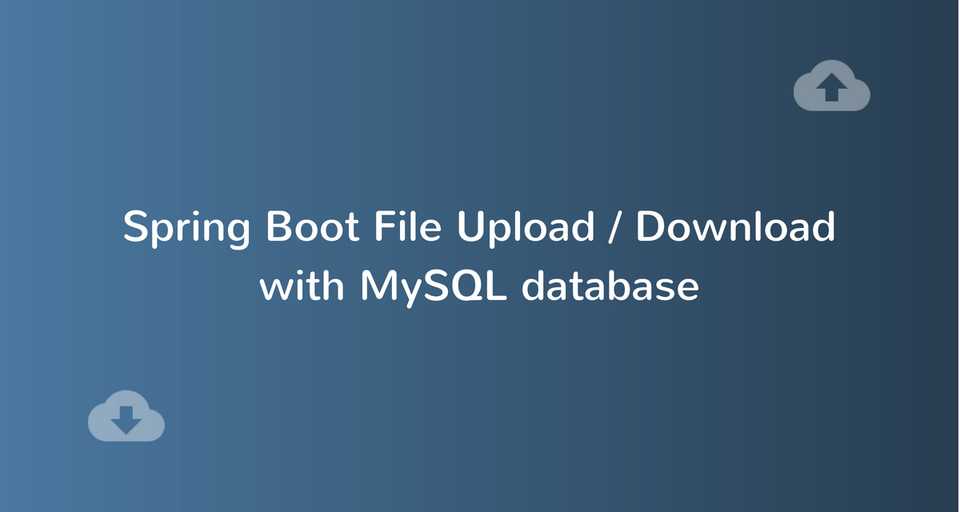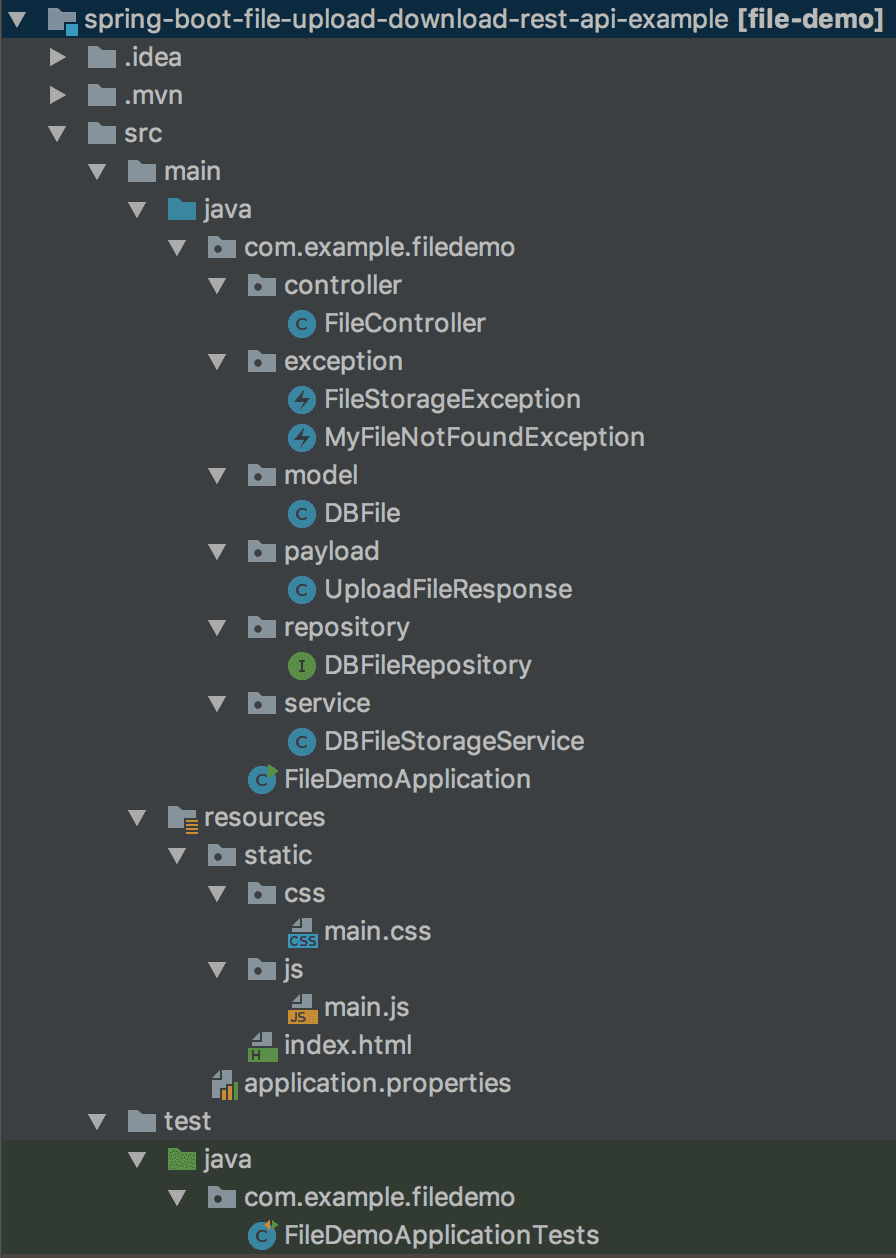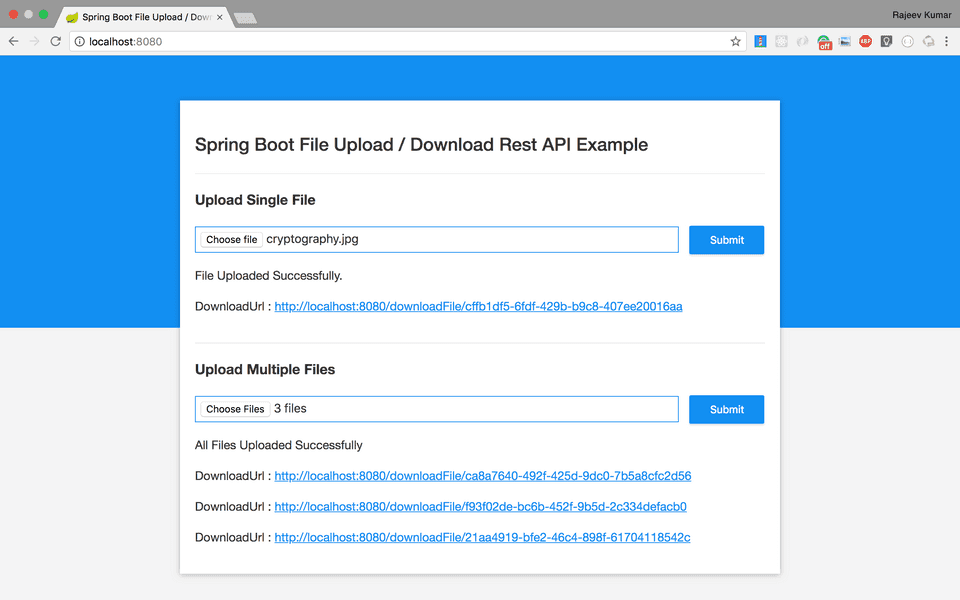Spring Boot File Upload / Download with JPA, Hibernate, and MySQL database
Spring BootJuly 07, 20181 mins readIn this article, you’ll learn how to upload and download files in a Restful spring boot web service. The files will be stored in MySQL database.
This article is a continuation of an earlier article where I’ve shown how to upload files and store them in the local filesystem.
We’ll reuse most of the code and concepts described in the last article. So I highly recommend you to go through that before reading this one.
The complete code is available in the Github repository.
Following is the directory structure of the complete application for your reference -
JPA and MySQL dependencies
Since we’ll be storing files in MySQL database, we’ll need JPA and MySQL dependencies along with Web dependency. So make sure that your pom file contains the following dependencies -
<dependencies>
<dependency>
<groupId>org.springframework.boot</groupId>
<artifactId>spring-boot-starter-web</artifactId>
</dependency>
<dependency>
<groupId>org.springframework.boot</groupId>
<artifactId>spring-boot-starter-data-jpa</artifactId>
</dependency>
<dependency>
<groupId>mysql</groupId>
<artifactId>mysql-connector-java</artifactId>
<scope>runtime</scope>
</dependency>
<dependency>
<groupId>org.springframework.boot</groupId>
<artifactId>spring-boot-starter-test</artifactId>
<scope>test</scope>
</dependency>
</dependencies>If you’re building the project from scratch, you can generate the project skeleton from Spring Initialzr website.
Configuring the Database and Multipart File properties
Next, we need to configure the MySQL database url, username, and password. You can configure that in the src/main/resources/application.properties file -
## Spring DATASOURCE (DataSourceAutoConfiguration & DataSourceProperties)
spring.datasource.url= jdbc:mysql://localhost:3306/file_demo?useSSL=false&serverTimezone=UTC&useLegacyDatetimeCode=false
spring.datasource.username= root
spring.datasource.password= callicoder
## Hibernate Properties
# The SQL dialect makes Hibernate generate better SQL for the chosen database
spring.jpa.properties.hibernate.dialect = org.hibernate.dialect.MySQL5InnoDBDialect
spring.jpa.hibernate.ddl-auto = update
## Hibernate Logging
logging.level.org.hibernate.SQL= DEBUG
## MULTIPART (MultipartProperties)
# Enable multipart uploads
spring.servlet.multipart.enabled=true
# Threshold after which files are written to disk.
spring.servlet.multipart.file-size-threshold=2KB
# Max file size.
spring.servlet.multipart.max-file-size=200MB
# Max Request Size
spring.servlet.multipart.max-request-size=215MBThe above properties file also has Multipart file properties. You can make changes to these properties as per your requirements.
DBFile model
Let’s create a DBFile entity to model the file attributes that will be stored in the database -
package com.example.filedemo.model;
import org.hibernate.annotations.GenericGenerator;
import javax.persistence.*;
@Entity
@Table(name = "files")
public class DBFile {
@Id
@GeneratedValue(generator = "uuid")
@GenericGenerator(name = "uuid", strategy = "uuid2")
private String id;
private String fileName;
private String fileType;
@Lob
private byte[] data;
public DBFile() {
}
public DBFile(String fileName, String fileType, byte[] data) {
this.fileName = fileName;
this.fileType = fileType;
this.data = data;
}
// Getters and Setters (Omitted for brevity)
}Note that, the file’s contents will be stored as a byte array in the database.
DBFileRepository
Next, we need to create a repository to save files in the database and retrieve them back -
package com.example.filedemo.repository;
import com.example.filedemo.model.DBFile;
import org.springframework.data.jpa.repository.JpaRepository;
import org.springframework.stereotype.Repository;
@Repository
public interface DBFileRepository extends JpaRepository<DBFile, String> {
}DBFileStorageService
The following DBFileStorageService contains methods to store and retrieve files to/from the database -
package com.example.filedemo.service;
import com.example.filedemo.exception.FileStorageException;
import com.example.filedemo.exception.MyFileNotFoundException;
import com.example.filedemo.model.DBFile;
import com.example.filedemo.repository.DBFileRepository;
import org.springframework.beans.factory.annotation.Autowired;
import org.springframework.stereotype.Service;
import org.springframework.util.StringUtils;
import org.springframework.web.multipart.MultipartFile;
import java.io.IOException;
@Service
public class DBFileStorageService {
@Autowired
private DBFileRepository dbFileRepository;
public DBFile storeFile(MultipartFile file) {
// Normalize file name
String fileName = StringUtils.cleanPath(file.getOriginalFilename());
try {
// Check if the file's name contains invalid characters
if(fileName.contains("..")) {
throw new FileStorageException("Sorry! Filename contains invalid path sequence " + fileName);
}
DBFile dbFile = new DBFile(fileName, file.getContentType(), file.getBytes());
return dbFileRepository.save(dbFile);
} catch (IOException ex) {
throw new FileStorageException("Could not store file " + fileName + ". Please try again!", ex);
}
}
public DBFile getFile(String fileId) {
return dbFileRepository.findById(fileId)
.orElseThrow(() -> new MyFileNotFoundException("File not found with id " + fileId));
}
}FileController (File upload/download REST APIs)
Finally, following are the Rest APIs to upload and download files -
package com.example.filedemo.controller;
import com.example.filedemo.model.DBFile;
import com.example.filedemo.payload.UploadFileResponse;
import com.example.filedemo.service.DBFileStorageService;
import org.slf4j.Logger;
import org.slf4j.LoggerFactory;
import org.springframework.beans.factory.annotation.Autowired;
import org.springframework.core.io.ByteArrayResource;
import org.springframework.core.io.Resource;
import org.springframework.http.HttpHeaders;
import org.springframework.http.MediaType;
import org.springframework.http.ResponseEntity;
import org.springframework.web.bind.annotation.*;
import org.springframework.web.multipart.MultipartFile;
import org.springframework.web.servlet.support.ServletUriComponentsBuilder;
import java.util.Arrays;
import java.util.List;
import java.util.stream.Collectors;
@RestController
public class FileController {
private static final Logger logger = LoggerFactory.getLogger(FileController.class);
@Autowired
private DBFileStorageService dbFileStorageService;
@PostMapping("/uploadFile")
public UploadFileResponse uploadFile(@RequestParam("file") MultipartFile file) {
DBFile dbFile = dbFileStorageService.storeFile(file);
String fileDownloadUri = ServletUriComponentsBuilder.fromCurrentContextPath()
.path("/downloadFile/")
.path(dbFile.getId())
.toUriString();
return new UploadFileResponse(dbFile.getFileName(), fileDownloadUri,
file.getContentType(), file.getSize());
}
@PostMapping("/uploadMultipleFiles")
public List<UploadFileResponse> uploadMultipleFiles(@RequestParam("files") MultipartFile[] files) {
return Arrays.asList(files)
.stream()
.map(file -> uploadFile(file))
.collect(Collectors.toList());
}
@GetMapping("/downloadFile/{fileId}")
public ResponseEntity<Resource> downloadFile(@PathVariable String fileId) {
// Load file from database
DBFile dbFile = dbFileStorageService.getFile(fileId);
return ResponseEntity.ok()
.contentType(MediaType.parseMediaType(dbFile.getFileType()))
.header(HttpHeaders.CONTENT_DISPOSITION, "attachment; filename=\"" + dbFile.getFileName() + "\"")
.body(new ByteArrayResource(dbFile.getData()));
}
}Results
I’ll be reusing the complete front-end code that I demonstrated in the first part of this article. You should check out the first article to learn more about the front-end code, or download it from Github.
Once you have the front-end code in place, type the following command to run the application -
mvn spring-boot:runHere is a screenshot of the final app -
That’s all for now. Thanks for reading!


